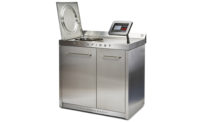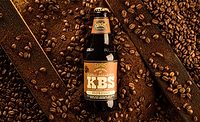Table-top seaming enables on-premise craft beer canning
Nearly 400 craft brewers package beer in cans, Aluminum Association reports

Cigar City Brewing in Tampa, Fla., uses Dixie Canner Co.’s tabletop 25D-900 Direct Drive Seamer to fill and seam cans on site according to consumer orders. (Image courtesy of Dixie Canner Co.)

CMC-KUHNKE’s Maura Marcks suggests adding a seam inspection program to seaming operations to catch issues with production. (Image courtesy of CMC-KUHNKE Inc.)

CarnaudMetalbox Engineering expanded its Academy of Canmaking and Seaming at its Shipley, U.K., headquarters last October to better train engineers in canning equipment operations. (Image courtesy of CarnaudMetalbox Engineering)



In the past 13 years, the aluminum can market has come a long way within the craft beer segment. Back in 2002, only one craft brewer packaged its beer in aluminum cans, according to the Aluminum Association. More recently, the demand for aluminum in general increased 2 percent in 2013 to 24.2 billion pounds, the Arlington, Va.-based association states in its October 2014 report “Aluminum Statistical Review for 2013.” Part of this growth is driven by the nearly 400 craft brewers who now package more than 1,300 different beers in cans in order to take advantage of the packaging material’s light and oxygen barriers and recyclability, it reports.
In order to take advantage of these benefits for their canning needs, craft brewers need to invest in can fillers and seamers that can meet their production needs, which tend to be significantly less than those of larger beverage-makers, points out Michael A. Mangone, managing member and director of sales and marketing at ShoreLine Packaging and Processing Machinery LLC, Havre de Grace, Md. “Many of these customers do not run [a fast] enough line speed to justify certain types of seaming equipment,” he explains. “For example, there are six-station seaming machines out there that cannot run properly below 300 cans a minute, and this is often too fast for many of the craft brewers.”
To better suit craft brewers’ production pace, original equipment manufacturers have developed lines that are better equipped for these smaller runs. For example, ShoreLine offers the F series seamers from Schafisheim, Switzerland-based Ferrum Ltd. and Stow, Ohio-based PneumaticScaleAngelus’ (PSAngelus’) Angelus V-Series seamers, which offer a minimum of three stations instead of six, Mangone says. In addition, both product lines offer all-stainless-steel seaming areas for improved sanitation and protection from cleaning solutions, he notes. Ferrum’s seamers also include a speed-dependent carbon dioxide gassing system that helps control carbon dioxide usage, he adds.
Although some craft brewers might start out with smaller production runs, they also need to plan for potential growth in the future, notes Maura Marcks, marketing manager for CMC-KUHNKE Inc., Albany, N.Y. “Craft brewers are typically on a tighter budget and have less output than mainstream beverage companies,” she explains. “Therefore, they seek out customized solutions that fit their small production needs and budgets … CMC-KUHNKE’s systems are also designed to be modular, allowing the systems to grow alongside small breweries as production grows.”
These types of machines are not just for the craft brewers, though, points out Parrish Stapleton, managing partner of Dixie Canner Co., Athens, Ga. “Our seamers are used by large macro-breweries for package testing, special marketing runs, etc.” he explains. “We offer very cost-effective can seamers with production of up to 1,800 cans per hour. For many brewers, they will find the Dixie Double Seamers will handle their production requirements.”
Custom canning
For the craft brewers who sell their beers on-premise, Dixie Canner also offers a tabletop 25D-900 Direct Drive Seamer, which can seam up to 15 cans a minute, according to the company website. Cigar City Brewing, Tampa, Fla., purchased the seamer so that it could start selling “Crowlers” — a lightweight, aluminum can version of a growler — at its brewery in the middle of last year.
The brewing company opted for 32-ounce Crowlers from Ball Corp., Broomfield, Colo., because of their portability and ability to keep beer fresher for longer, Russell Breslow of Cigar City Brewing’s media and marketing department told Dixie Canner Co. in a
Sept. 29, 2014, blog post. Breslow said that tourists often stop in to pick up beers to take with them on their vacations or take home with them in their suitcases. The cans are lightweight, portable, and don’t pose a hazard of breaking in the same way a glass growler would, he said. After the consumers enjoy the craft beer, they can recycle the can in most recycling receptacles, he added.
The tabletop seamer allows the brewery’s employees to fill and seam cans on the spot as consumers request them, according to the blog post. “The Dixie seamer has pride of place right up on the countertop within easy access for the bartenders and customers,” the company wrote. “Customers select their beer, and then bartenders fill the 32-ounce can straight from the tap and seam it on the spot.” Cigar City Brewing also uses generic labels on the Crowlers so that bartenders can write the beer’s name on the can, it added.
On top of the quick, custom-seaming benefits, Cigar City Brewing’s Breslow also reported that the 25D-900 Direct Drive Seamer was easy to install and start. “Within an hour, we were up and running,” he reported. “Set up was easier and quicker than we expected.”
Knowledge is power
Easy start-up and operation is an important feature many beverage-makers look for in their can-filling and -seaming equipment, Dixie Canner’s Stapleton says. “Most companies interested in investing in can lines usually have little or no experience with can packaging,” he says. “They have questions, but really what they need is clear, proven information on the overall process, cost and production rates.”
Dixie Canner provides detailed user guides, instructional videos on YouTube, and over-the-phone customer service to help with seamer operations, Stapleton says. “We have walked customers from around the world through various [equipment] adjustments,” he notes.
This aid is especially important considering that there is a shortage of experienced employees in the field, ShoreLine’s Mangone adds. “One of the biggest issues facing many companies is the lack of available in-house expertise on this equipment,” he says. “Many of the people that maintained these machines for many years have already retired, and there are not nearly enough people filling these positions. The can manufacturers and outside machinery rebuilders help wherever possible, but the actual processors are having a difficult time hiring and retaining qualified people. A qualified seamer technician takes years to develop properly.”
To help beverage-makers continue operation as their experienced staff retires, CMC-KUHNKE offers localized technical support through a network of agents and regional offices across the United States, Mexico, Germany and China, Marcks notes.
CarnaudMetalbox (CMB) Engineering opened the Academy of Canmaking and Seaming at its Shipley, U.K., headquarters last March to train engineers to operate canning equipment. Last October, the company announced expanded facilities featuring three classrooms for lessons in addition to the academy’s original workshop area that offers hands-on instruction with CMB, Ferrum and PSAngelus machines. The academy’s seamer courses are taught by a team of seaming engineers and supported by a set of standard operating procedures, illustrations and videos.
Carlsberg Breweries A/S, Copenhagen, was one of the academy’s first students and sent four engineers to learn more about the Ferrum F series seamers as well as seam evaluation, the company says.
“It was great to have the opportunity to be trained by our supplier partner at their headquarters,” said Jonathan Woolhead, can-making engineer at Carlsberg, in a statement. “The academy really served its purpose as a stress-free and safe environment to train in, and the course was very useful to help reinforce can-making skills and knowledge.”
Parts and maintenance
Once operators know how to work the machines, they also have to take steps to keep them up and running and ensure that they are producing quality packages. “If the equipment is worn out or the tooling, like chucks and rolls, is worn or damaged, then the seams are directly affected,” ShoreLine’s Mangone explains. “It is important that the processors pay careful attention to these factors and check the condition of the machinery on a regular basis. The equipment itself cannot make any guarantees. It is the setup of that equipment that ensures the best possible result.
“For example, assuming that the machine is in good condition, the proper profile and material for the seaming chucks and rolls is critical to seam quality,” he continues. “If this is not correct, then it is likely that the dimensions for the finished seams will not be within the manufacturer’s specifications. In extreme cases, bad seams cause product to be put on hold or destroyed because it has spoiled or developed leaks.”
In order to anticipate these problems and keep the machines up and running, beverage-makers need to have a quality control (QC) and maintenance plan in place, Dixie Canner Co.’s Stapleton says. “Machinery is like a car: It needs to be maintained, lubricated, cleaned [and] adjusted,” he says. “The better your QC and maintenance program, the better your results.”
CMC-KUHNKE’s Marcks suggests adding a seam inspection program to seaming operations to catch issues with production. For example, CMC-KUHNKE’s SEAMscan Statistical Process Control (SPC) customizable, high-resolution double-seam inspection system and its non-destructive SEAMscan XTS double-seam inspection system monitor seams and store data for SPC, revealing trends and allowing for scheduled seamer adjustments and minimized downtime, she explains.
Even when machines are running properly, downtime caused by adjusting the seamers to accommodate different can sizes negatively impacts production and needs to be minimized, experts note. For example, some automated machinery can take hours or even days to make changeovers to accommodate different can diameters because other connected systems, including the can filler, conveyors and labeling systems, need to be adjusted as well, Dixie Canner’s Stapleton says. This can cause a sizable delay in production for beverage-makers who have only one canning line, he notes. By comparison, beverage-makers can make tooling changeovers and adjustments to accommodate different can diameters on the Dixie Model 25D-900 seamer in 10-15 minutes, he explains. Adjusting for different can heights, on the other hand, also usually is a quick adjustment that requires a change in base plate, he adds.
These quick-changeover features will continue to be important going forward as beverage-makers opt for a variety of packaging styles. “I see more can sizes becoming popular,” Dixie Canner’s Stapleton says. “The size and shape of typical 12-ounce, 16-ounce and Imperial Pints will vary [with] new, slimmer shapes, taller heights and more size options. These will be more product- and market-driven, but brewers will use the available packaging to help distinguish themselves in the marketplace.”
Looking for a reprint of this article?
From high-res PDFs to custom plaques, order your copy today!













